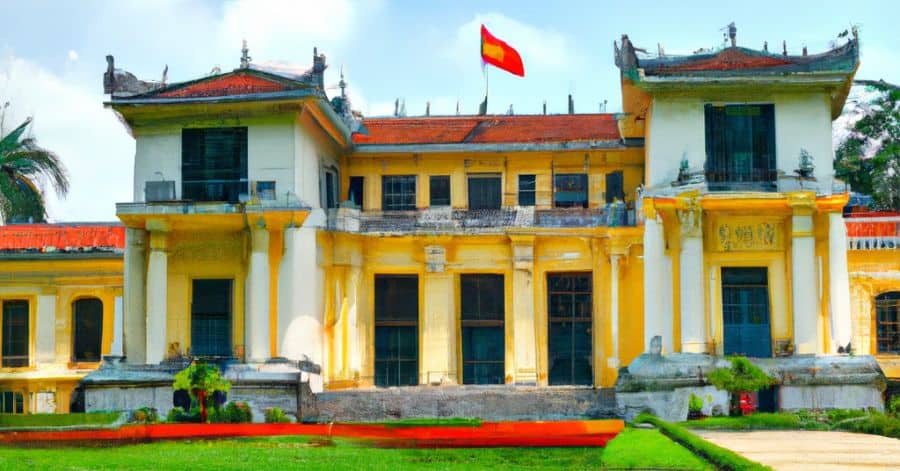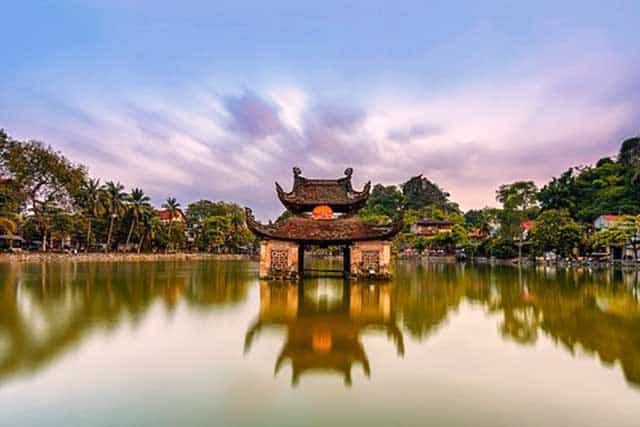What are famous Museums in Hanoi? With a history that goes back more than a thousand years, Hanoi has a lot to offer that can’t be seen in just a few days. So, many tourists choose to go to museums to learn more about the city and the country. There are about 20 museums in Hanoi, but we’ve selected ten of the best ones you can’t miss if you are a history lover. We hope this list will help you decide which one you want to explore.
Read also:
- Top 5 Best Drinks in Hanoi And Where To Find
- 15 Best Vegetarian and Vegan Restaurants in Hanoi
- Top 5 Best Foods in Hanoi and Where To Enjoy
- Local Markets In Hanoi: Where Is The Best Place To Go Shopping?
Vietnam National Museum of History
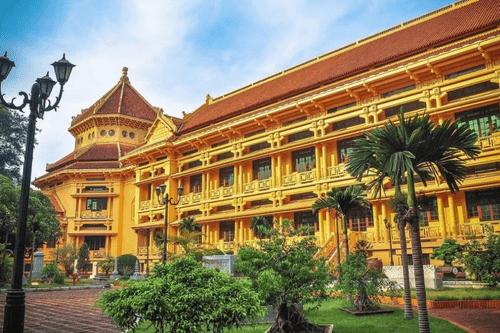
Source: vietnamonline.com
The Vietnam National Museum of History is in the Hoan Kiem district – the heart of Hanoi. It has artifacts from prehistoric times (about 400,000 years ago) up to the founding of the Democratic Republic of Vietnam. The Museum is in the style of French colonial architecture and has beautiful balconies. It used to be a place where the French School of Asian Studies researched archaeology.
The Vietnam National Museum of History is in two different locations. It has a lot of other things from Vietnam’s past. Generally, it shows valuable artifacts and discusses how the country came to be. Above all, the Museum has about 200,000 objects from the Neolithic age, the Bronze age, the Sa Hung, Oc Eo, and Hung periods, the Nguyen dynasty, the Cham period, and the Dong Son culture lived from about 1000 BC to 100 AD in northern Vietnam.
Why must you visit?
This Museum is more than 2,000 square feet and has four different sections:
- Section 1 is about the Stone Age, which happened 30,000 and 40,000 years ago.
- Section 2 is about the Tran Dynasty.
- Section 3 is about the Ho Dynasty to the August 1945 Revolution.
- Section 4 has sculptures made of stone by the Champa people.
Even though the Museum is only 2,000 square meters, it gives an excellent overview of Vietnam’s history because it is in chronological order. To understand the artifacts and relics in the Museum, visitors may need to use their imaginations and be sensitive. Hence, this is an excellent chance to see how well you understand art since most descriptions are Vietnamese and only say what the object is, not what it means.
- Entry fee: Adults: 1.5 – 2 USD, Students: 0.5 – 1 USD
- Opening hours: Tuesday – Sunday 8:00 am to 12:00 pm, 1:30 pm to 5.00 pm.
- Website: https://baotanglichsu.vn/en
- Addresses: You should start at Trang Tien street and then go to Tran Quang Khai street to see the rest
- No. 01, Trang Tien street, Hoan Kiem District, Hanoi: ancient and medieval Vietnamese history
- No. 216, Tran Quang Khai street – Hoan Kiem District, Hanoi: Vietnamese history near-modern
TourTeller’s Pick! – Best Hanoi Tours






Vietnam Museum of Ethnology
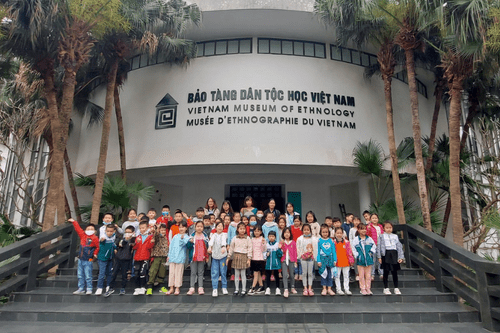
Source: btdth
The Vietnam Museum of Ethnology is one of the most famous museums in Hanoi, which has been open since 1997. It has many important events throughout the year, especially on holidays like the Lunar New Year, the anniversary of the Hung Kings, and the Mid-Autumn Festival.
This Museum in Hanoi is a perfect place to learn and study how people in Vietnam live and think. It is proud of the South-East Asian artifacts because it has and shows to the public. It has photos, audiotapes, antiques, and everyday things like baskets and knives that offer what life was like for the 54 officially recognized ethnic groups. There is also information about each group’s ceremonies and rituals, and there are replicas of Vietnamese homes.
Why must you visit?
The indoor Museum has a massive collection of more than 15,000 objects that show how people from different ethnic groups, like the Viet, Muong, Tho, Khmer, Chut, and others, lived. Many things are on display, like old photos, jewelry, and other items used in traditional weddings and spiritual ceremonies.
A virtual tour is also available. The outdoor Museum is an excellent place to take a walk through the well-kept trees, streams, and bridges. It has beautiful gardens and architecture that looks like old houses in Vietnam. Hence, it would be best to keep an eye out for more exciting displays, like the Vietnamese art form of water puppet theater.
- Entry fee: Adults: 1.5 – 2 USD, Students: 0.5 – 1 USD, Camera: 2 USD (additional fee), Children under six years are free.
- Opening hours: Tuesday to Sunday from 8:00 am to 12:00 pm, 1:30 pm to 5.00 pm.
- Website: http://www.vme.org.vn/en
- Addresses: Nguyen Van Huyen street, Cau Giay district, Hanoi
TourTeller’s Pick! – Best Hanoi Food Tours






Vietnam National Fine Arts Museum
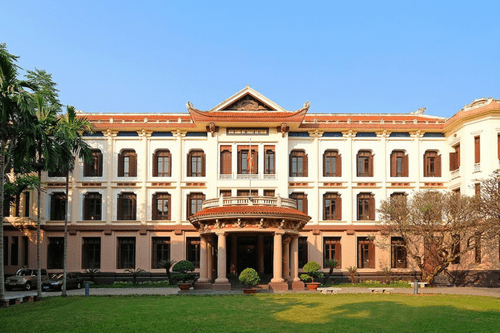
Source: vnfam.vn
Art lovers from all over the world come to see this Museum, both because of the quality of its collections and because the old building is so beautiful. This building used to be a boarding school for the daughters of government officials in France. It has a unique collection of art treasures from every period in Vietnamese history, from early prehistory and classical antiquity to the epic story of Vietnamese creative genius in the modern age.
One of Hanoi’s most beautiful and well-known museums is the Vietnam Fine Arts Museum. It is in a beautiful French Colonial building that was once the home and office of the French Ministry of Information. This is a great place to show the best Vietnamese culture because it has traditional, religious, modern, and abstract art.
Why must you visit?
The Vietnam Fine Arts Museum is a three-story building with an organized collection of works that show how painting styles changed from Dong Ho art to Hang Trong art and embroidery art (schools of Vietnamese painting). Vietnam has called many sculptures, images, and lacquer pieces “national treasures.”
Attractions at this Museum include a wooden door with dragon carvings, a statue of Bodhisattva Avalokiteshwara, a statue of Guanyin, the Goddess of Compassion, with a thousand arms and eyes, a vase painted by the famous Vietnamese painter Nguyen Gia Tri with two paintings called “The Girl in the Garden” and “Landscape,” and a paper painting called “French National Celebration Day.”
Several paintings show scenes from the Vietnamese resistance, a powerful reminder of patriotism, sacrifice, and protecting the country. The Applied Arts Pavillion is a fascinating look into the anthropological history of the South-East Asian country through its collection of traditional folk art.
- Entry fee: 1.5 – 2 USD
- Opening hours: Like most museums in Hanoi, it is closed on Mondays but open on Tuesdays – Saturdays from 8:30 am to 5 pm.
- Website: https://vnfam.vn/en/
- Address: No. 66, Nguyen Thai Hoc street, Ba Dinh district, Hanoi
Vietnamese Women’s Museum in Hanoi
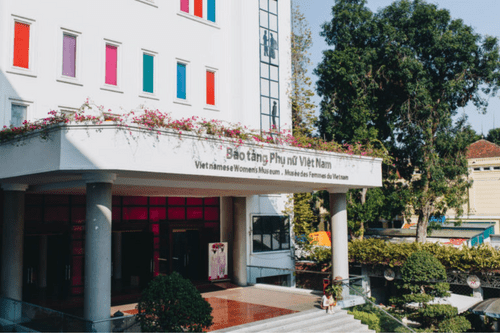
Source: iawm.international
The Woman’s Union of Vietnam runs the Vietnamese Women’s Museum, which has many displays that honor Vietnamese women from different times and places. It celebrates women in all roles, such as mothers, street vendors, war heroes, and business leaders, and gives detailed information about each.
The role of women in building Vietnamese society has been vital. The Vietnamese Women’s Museum has text-based and audiovisual displays that beautifully show this important social journey of Vietnamese women.
The Vietnamese Women’s Museum is in the center of Hanoi. It has more than 2,000 square meters of exhibit space with over 28,000 objects and documents. Each floor of the Museum shows a different part of a woman’s life, from family to history to fashion. In addition to the exhibits, the Vietnamese Women’s Museum hosts conferences, workshops, mobile exhibitions, and public education seminars in addition to the shows.
Why must you visit?
In Vietnam’s history and culture, women have always been at the center of things. Because of this, there is no question that this part of the world has its Museum. Women in Family, Women in History, and Women’s Fashion are the three permanent exhibits at the Museum. By teaching people about Vietnamese women and helping them understand them, the Museum hopes to help make sure that men and women have the same rights in Vietnam.
The Vietnamese Women’s Museum’s main building has four different areas on its five floors: the Permanent Exhibition, the Special Exhibition, the Discovery Room, and the Museum Shop. Temporary exhibitions are put on in an area close to the building.
The most exciting things to see at the Museum are the videos and photos showing how Vietnam’s brave mothers lived during the war.
Permanent displays are on the Vietnamese Women’s Museum’s second, third, and fourth floors. Significantly, more than a thousand things, materials, and pictures are spread over these floors. The three main topics are women in Family, Women in History, and Women in Fashion.
- Entry fee: 1.5 USD
- Opening hours: 8 am – 5 pm, Monday – Sunday
- Website: https://baotangphunu.org.vn/en/
- Address: No. 36, Ly Thuong Kiet street, Hoan Kiem district, Hanoi
Vietnam Military History Museum
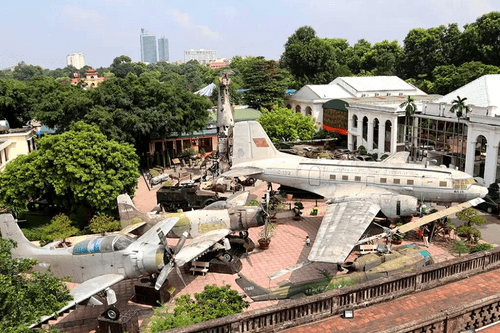
Source: vietnamtravel.com
The Vietnam Military History Museum, also called the Army Museum, has authentic war relics, a collection of weapons used during the Vietnam War, artifacts, and detailed accounts of war soldiers. A MiG21 jet fighter, an M107 gun, a military tank, and many other things from the war are extensive and exciting war relics. For people interested in the Vietnam War, the Museum is well put together and has a lot of information.
There are seven national museums in Vietnam, and this Museum in Hanoi is one of them. It has a fantastic collection of actual war artifacts, photos, and stories from its long wars with China, France, and the United States. On the 15th anniversary of the Vietnam People’s Army in 1959, the Museum opened. Since then, it has collected, stored, and put more than 150,000 items on display. It is known as a place where Vietnam’s war history is kept.
Why must you visit?
The Vietnam Military History Museum has displays that show how violent Vietnam’s past was. The artifacts tell the story of Vietnam’s past, from Huong Vong to Ho Chi Minh, and the exhibits are split into an inner and an external system. Some of the most famous artifacts are the American B-52 bomber, the M107 self-propelled gun, and the military tank that ended the Vietnam War in 1975 by driving through the gates of Saigon’s Presidential Palace.
The old building is mainly about the wars in Vietnam before World War II. This includes the colonization by the Chinese and the French, the occupation by the Japanese, the rise of Viet Minh in North Vietnam, and the country’s independence in 1945. And the newer building is all about Vietnam’s wars with the U.S., how the Viet Cong fought, and how the American War changed Vietnam as it is now.
- Entry fee: There is a separate cost if you want to take in cameras that varies with the hour: less than an hour: 1.2 USD, 1 – 2 hours: 1.5 USD, and 2 – 3 hours: 2 USD
- Opening hours: Tue – Thu: 8 AM – 11:30 AM, 1 PM – 04:30 PM, Sat-Sun: 8 AM – 11:30 AM, 1 PM – 04:30 PM
- Website: https://baotanglichsuquansu.vn/en-gb/
- Address: No. 28A, Dien Bien Phu street, Ba Dinh district, Hanoi
Vietnam Museum of Literature
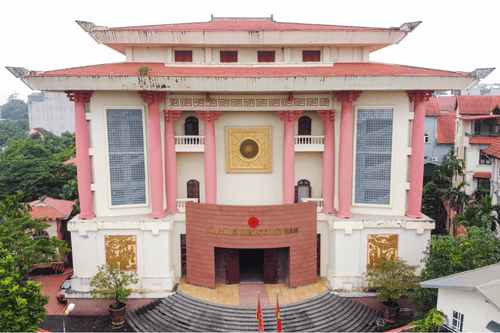
Source: baotangvanhoc.vn
The Vietnam Writers Association opened the Vietnam Literature Museum at 275 Au Co Street in Hanoi’s Tay Ho District. It is 3,000 square meters big and has more than 4,000 artifacts and documents about writers and their works on display.
In 2011, the Prime Minister gave the go-ahead to build the Vietnam Museum of Literature, run by the Vietnam Writers Association. The Vietnam Literature Museum has the job of collecting, restoring, researching, exhibiting, introducing cultural heritages, and showing how Vietnam literature came to be and grew over time. There are three floors in the Museum. On the first floor is an exhibit of artifacts and documents from ancient and medieval Vietnam that have to do with writing. At the center is a stone in the shape of a pen that was brought from Hung Temple and has the words of the great poet Nguyen Du carved into it.
Here is an exhibit of Vietnamese literature from the 10th to the 19th century and the history of writing Vietnamese characters on paper, cloth, metal, and leaves. This is one of the most important cultural and literary museums in Vietnam.
Why must you visit?
The Museum has three floors and a total area of 3,600 square meters. It costs almost 50 billion VND (2.3 million USD) to build and has spaces for events and exhibitions:
- On the first floor, you can learn about the country’s literacy from the 10th to the 19th centuries and the history of Vietnamese scripts on different materials like paper, fabric, metal, and leaves.
- On the second floor, you can learn about Vietnamese literary figures from the early 20th century, like Phan Boi Chau, Tan Da, and Ho Chi Minh, as well as winners of the Ho Chi Minh Prize for Literacy.
- On the third floor, writers who have won the State Prize for Literacy and Fine Arts will be shown.
In addition to documents, manuscripts, and writers’ first books, the Museum has computers and projectors to make it easier for people to search for information.
- Entry fee: 1 USD
- Opening hours: Museum of Vietnam Literature is open daily from 8 am to 6 pm.
- Website: https://baotangvanhoc.vn/
- Address: No. 275, Au Co street, Tay Ho district, Hanoi
Vietnam National Museum of Nature
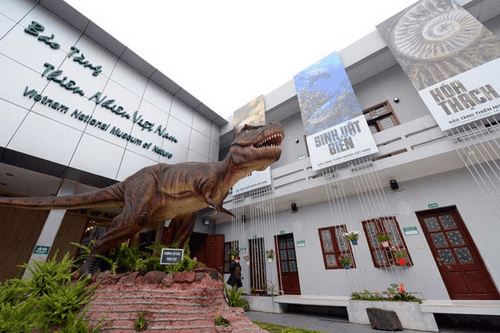
Source: travelhanoi.org
The Museum opened in 2014 and is a great place to learn about the plants and animals of Vietnam. Visitors to the Vietnam National Museum of Nature can go back to see how species have changed over time.
The history of life exhibit has warm light and colors that are very nice to look at. Fossils from the pre-Cambrian period (4,500 to 541 million years ago), the Mesozoic period (541 to 252 million years ago), and the Great Neoplasm are on display (66 million years to the present day).
Animal bones from frogs, carp, king cobras, tigers, ostriches, and pig-tailed monkeys are displayed in a way that shows even the most minor details. The Vietnam National Museum has the most extensive collection of insects in Vietnam. The insects are into groups like beetles, dragonflies, cicadas, mantises, and stick insects. Some of these insects lived 400 million years ago.
Why must you visit?
The Vietnam National Museum of Nature is at 18 Hoang Quoc Viet, Cau Giay dist, Hanoi. It is inside the Academy of Science and Technology of Vietnam. Nearly 1,400 specimens are in a small area of more than 300 square meters. Still, they tell the story of the origin of life and nature in Vietnam over the past 3.6 billion years. History of life with fossils from the Precambrian period (4,500–541 million years ago), Paleozoic period (541–252 million years ago), Great Plains period (252–66 million years ago), and the New Age (66 million years ago).
On the surface of the wood, the evolutionary tree is in great detail. It offers a variety of life with five organisms: pre-human, progenitor, fungal, plant, and animal. There are also a variety of vertebrates and marine life, like pangolins, lizards, tigers, snakes, seahorses, sea stars, coral, and oysters. There are a variety of vertebrates and marine life, like pangolins, lizards, tigers, snakes, seahorses, sea stars, coral, and oysters.
- Entry fee: Adults: 1.5 USD, children: 0.5 USD. Entrance to the Vietnam National Museum of Nature is free from Thursday to Sunday.
- Opening hours: Tuesday – Sunday 8:30 am – 11:30 am, 1:30 pm – 4:30 pm
- Website: http://vnmn.ac.vn/
- Address: No. 18 B-C, Hoang Quoc Viet street, Cau Giay district, Hanoi
Geology Museum in Hanoi
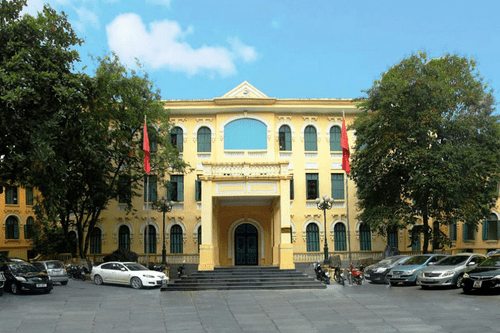
Source: gpsmycity.com
The Geological Museum in Hanoi is close to the National Museum of Vietnamese History. It is a unique place to learn about the rocks, fossils, and gemstones found in Vietnam. The collections are divided into sections that give detailed information about how the country’s geology has changed over time and how many minerals it has.
The French colonists in Indochina set up the Geological Survey of Indochina in 1898. Two geologists, H. Lantenois and H. Mansuy, were asked to build a museum to hold many things found during the survey.
Vietnam’s Department of Geology and Minerals is now in charge of the Museum. The exhibits are divided into three main groups and 12 smaller groups. The part about how geology has changed over time shows how many of Vietnam’s beautiful natural sights came to be.
Why must you visit?
In 1914, a beautiful building with a French style was built to store a lot of things, rocks, fossils, and gems from all over the country. When the Museum first opened, it only had one floor. In 1915, two more beds were added so that all specimens found during and after the first geological survey could be shown off well.
The Geology Museum’s three main themes are the geological history of Vietnam and our planet, the geology and minerals of Vietnam, and thematic collections. The Museum has a lot of geological, mineral, and paleontological samples from all over the United States, including a lot from the Northwest. You can look at the exciting and colorful minerals, considered “nature’s art.”
Many geological books at the Museum will interest visitors and students. Ruby is the most common gemstone in Vietnam, and visitors can buy them at a store nearby.
The Geological Museum is in a beautiful French building from the turn of the 20th century. It has thousands of rocks and minerals on display. The geo-novice gets basic information in the form of vague blurbs. Maps with many colors that look like works of art show how Vietnam’s geology and resources have changed over time. Samples of fossils, ores, and gemstones give students and scientists a wide range of helpful information. A shop next to the Museum sells rubies, Vietnam’s most common gemstones, for a small price.
- Entry fee: FREE
- Opening hours: from 8 am to 5 pm, Mondays – Fridays
- Website: http://dgmv.gov.vn/
- Address: No. 6 Pham Ngu Lao, Phan Chu Trinh, Hoan Kiem, Hanoi
Ho Chi Minh Museum
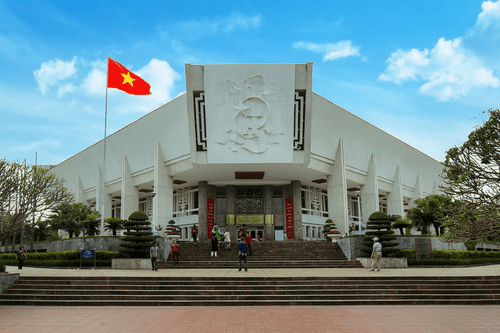
Source: tripadvisor.com
President Ho Chi Minh was a great man of culture and a hero of the Vietnamese people’s fight for freedom. After he died on September 2, 1969, the Politburo of the Communist Party of Vietnam decided to build the Ho Chi Minh Mausoleum and the Ho Chi Minh Museum. This was done to meet the wishes of the Vietnamese people.
On September 2, 1990, the President’s 100th birthday, the Ho Chi Minh Museum was opened after 20 years of planning and building. More than 170,000 documents, objects, and films at the Ho Chi Minh Museum tell about President Ho Chi Minh’s life and revolutionary work. They are essential to the Vietnamese because they teach patriotism, help people understand and follow Ho Chi Minh’s ideas and morals, and inspire new generations to finish his great revolutionary work well.
Why must you visit?
The Ho Chi Minh Mausoleum is well-known to most people, but only a select few are aware of the Ho Chi Minh Museum, which is housed within the Ho Chi Minh complex. The Museum focuses on Ho Chi Minh’s life from 1890 through 1969, as suggested by the Museum’s name.
- Entry fee: 1.75 USD/person
- Opening hours: Monday and Friday: 8 am–12 pm, Tuesday – Sunday: 8 am–12 pm, 2–4:30 pm
- Website: http://www.baotanghochiminh.vn/
- Address: No. 19, Ngoc Ha street, Ba Dinh district, Hanoi
Hanoi Museum
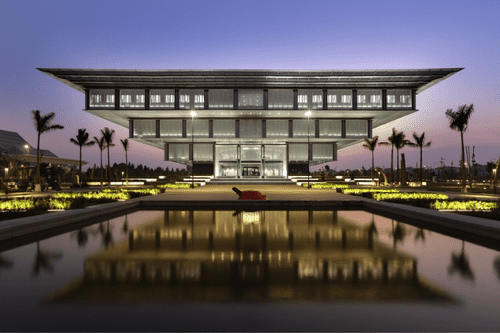
Source: archdaily.com
On the occasion of Hanoi’s millennium anniversary, the city’s Museum was presented to the public for the first time. At that time, the place was packed to the gills with citizens who were giddy with anticipation to learn more about the history of Hanoi. Others are drawn to this location due to its extraordinary inverted-pyramid shape with a ground floor without any columns.
Why must you visit?
The Hanoi Museum is in a park with a lot of water features. As soon as you walk into the Museum, you’ll see exhibits about the history of Hanoi and reconstructed traditional Vietnamese villages.
A circular atrium in the middle of the square building connects the level with the entrance to the three exhibition levels. These are set up like terraces that get wider as you go up, making an inverted pyramid shape.
The four-story building has 14,000 m2 of service and exhibition space. The building’s basement has two conference rooms and the systems that keep the facility running.
- Entry fee: 0.5 – 1 USD
- Opening hours: Tuesday through Sunday, from 8 am to 11:30 am and 1:30 pm to 4:30 pm; anyone can visit the Museum.
- Website: https://baotanghanoi.com.vn/
- Address: Pham Hung street, Nam Tu Liem district, Hanoi
We hope that the list above brings you a good idea of how great the museums in Hanoi are. Suppose you want to explore all of them and other popular Hanoi sites on your trip to Vietnam. You should book your journey through our TourTeller, which has the best deals on customized packages. And when you get back from your wonderful trip, don’t forget to tell us about it!
Check Out The Best Hanoi Tours








Best Food Tours & Cooking Classes












